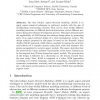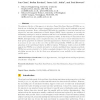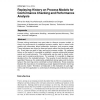2217 search results - page 393 / 444 » Learning from Collective Behavior |
AICOM
2002
13 years 8 months ago
2002
The computational potential of artificial living systems can be studied without knowing the algorithms that govern their behavior. Modeling single organisms by means of socalled c...
COGSCI
2008
13 years 7 months ago
2008
This article demonstrates the potential of using hierarchical Bayesian methods to relate models and data in the cognitive sciences. This is done using a worked example that consid...
TAOSD
2010
13 years 3 months ago
2010
The idea behind Aspect-Oriented Modeling (AOM) is to apply aspect-oriented techniques to (software) models with the aim of modularizing crosscutting concerns. This can be done with...
ATMOS
2011
12 years 9 months ago
2011
The primary objective of this paper is to introduce Fuzzy Rule-Based Systems (FRBSs) as a relatively new technology into airport transportation research, with a special emphasis o...
WIDM
2012
ACM
12 years 4 months ago
2012
ACM
Process mining techniques use event data to discover process models, to check the conformance of predefined process models, and to extend such models with information about bottl...



